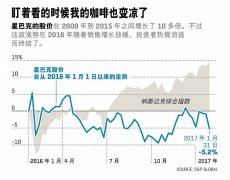Change the traditional joining model and see how a local coffee brand will transform in a decade?
For professional baristas, please follow the coffee workshop (Wechat official account cafe_style)
A 10-year-old local coffee chain brand has opened more than 200 stores in the franchise mode. How should it be transformed in the face of problems such as brand aging? The 36 Krypton consumer group introduced a lot of new brands before, but this time they want to see the transformation ideas of an "old" brand.
Laosai Coffee started in Xiamen in 2007, focusing on coffee take away, with more than 200 stores in the country. But over time, the team felt some problems. According to founder Lai Zhiwang, first of all, there is the problem of brand aging; secondly, the take away model is not very popular in China. Compared with the popular new tea, he thinks that the attribute of tea product is stronger, while the attribute of coffee is stronger; in addition, in the traditional joining model, there is a game of interests between the brand and the franchisee, and the Laosai team needs to invest a lot of management costs and cannot produce equal value.
Starting in 2014, the team began to explore new models. After thinking, groping and introducing talents, there is now a clear direction of transformation, and Let's say COFFEE, the first store after the transformation, was also opened in August last year. Below, we introduce the transformation of Laosai Coffee from three aspects: brand positioning, business model and supply chain cooperation.

First of all, look at the brand positioning, as mentioned earlier, the 1.0 version of Lao Coffee is mainly coffee takeout, and the storefront is smaller. The 2.0 version of the coffee shop will be about 100 square meters, pay attention to the space design, and add light food outside the coffee. Coffee shops are located in office buildings and mainstream business areas for business people. On the whole, the positioning of Lao Cai is similar to that of Starbucks, but there are three differences: first, the price of Starbucks is higher, the price of Starbucks is about 30 yuan, while that of Losse is about 20 yuan; the second is that the space design is younger than Starbucks; and finally, the most important point is that the clerk and the customer are interactive. Starbucks is well-known for its lack of interaction between shop assistants and customers and the lack of "human touch" advocated by the East. Lao Cai hopes that through corporate culture transmission, training, incentive and other mechanisms, so that the shop assistant can show the same warm state as the Japanese drama "late Night Canteen".
After talking about brand positioning, let's take a look at the business model of Laosai Coffee. In the traditional joining process, Laosai Coffee team found that the franchisee has the dual identity of operator and investor, but not everyone can take care of it. If the franchisee only wants to make financial investment and is unwilling to operate, the store situation will not be good. Therefore, Lao Cai decided to separate the financial investors from the store operators and change from the pure joining mode to the partnership mode.
Specifically, in terms of investment, Lao Sai adopts the collective investment model. The company unifies the development of several stores, calculates the total amount of funds needed, and then invites investors to invest in a unified pool of funds. As for operators, Lao Sai will select and hire people who are suitable for running stores and help set up a management team. Before the store gets back the capital, most of the profits go to the financial investors, and the operators get a fixed share. This is to first protect the interests of investors; and after cost recovery, investors are distributed in a fixed proportion (controlled within 15%), the operator and the management team get 20-25% of the turnover, and the management team has the opportunity to invest in stores. This is to encourage operators to operate attentively for a long time.
Lai Zhiwang believes that such a partnership model can reduce the investment risk of investors on the one hand and make the company a multilateral partnership platform on the other hand. If you treat each store as a project, you can incubate a lot of small teams that are willing to start a business.
Laosai Coffee not only opens up the organizational structure of the company, but also hopes to build a new model when working with the supply chain. In the past, the upstream supplier and the brand side is a simple buying and selling relationship, although the supplier will develop products according to the needs of the brand, but will not in-depth study of the specific needs of the C side. Laosai Coffee hopes that suppliers will not only provide products, but also understand the needs of Laosai customers, and then combine the sensitivity and experience of suppliers to develop products. If such products sell better, they will also share with suppliers. For professional baristas, please follow the coffee workshop (Wechat official account cafe_style)
Important Notice :
前街咖啡 FrontStreet Coffee has moved to new addredd:
FrontStreet Coffee Address: 315,Donghua East Road,GuangZhou
Tel:020 38364473
- Prev

No coffee without a fish tail! Thai Dream Mermaid Cafe makes you become Ariel!
Professional baristas Please follow the Coffee Workshop (official Wechat account cafe_style) Coffee shops with the theme of mermaids or unicorns may not be uncommon, but has NiMeng ever heard of cafes that "must be Cos into a mermaid to enter"? Today, the editor is going to introduce a mermaid-themed coffee located in "Pathum Thani" in central Thailand.
- Next

The share price is down. Is this cup of coffee cold?
Professional baristas follow the coffee workshop (Wechat official account cafe_style) many investors have lost interest in Starbucks since last year, although the company is growing faster than most of its competitors. Whether the coffee shop giant can't escape mediocrity in the long run. In the second half of last year, Ho, then CEO of Starbucks (Starbucks)
Related
- What documents do you need to go through to open a coffee shop? coffee shop coffee shop certificate processing process
- How to purchase Coffee beans in small Cafe how to choose a suitable supplier for domestic Coffee supply Company
- How to drink Starbucks Fragrance White Coffee? how to make Australian White Coffee? what Italian coffee beans are recommended?
- The Story of Flora Coffee: the name of Flora Coffee Bean and the implication of the Flowers on Florna Coffee
- How much does a cup of coffee cost? How much is the profit of a cup of coffee? What is the profit of the coffee shop in a year?
- Yunnan small Coffee, known as "fragrant Coffee", introduces the characteristics of Alpine Arabica Coffee producing areas in Yunnan, China
- 2023 latest Starbucks full menu price list how much is a cup of Starbucks coffee what is better to drink the most popular hot and cold drinks recommended
- Starbucks different kinds of Coffee Price list Starbucks menu 2023 Top Ten Best drinks in Starbucks
- Starbucks Spring praise Comprehensive matching Coffee Bean theme Story Packaging implication and taste description
- The cost of a cup of coffee latte American coffee cost price and selling price

